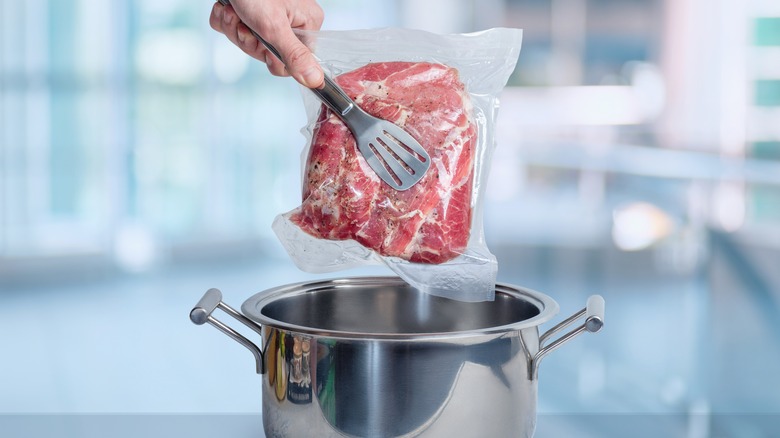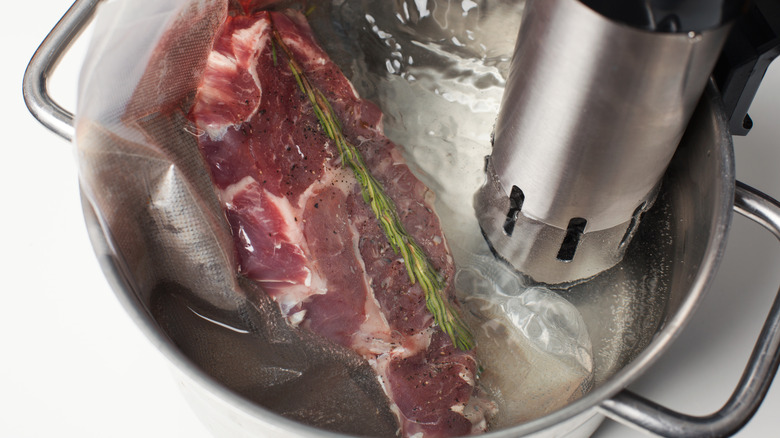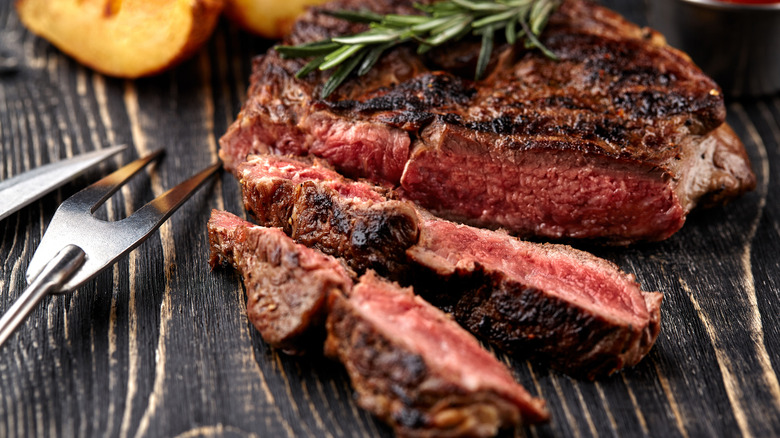Sous Vide Your Next Flank Steak And Thank Us Later
The best way to cook a steak is one of those debates that will probably rage across the internet until the Earth crashes into the sun. And there are all sorts of techniques you can use here, from the reverse marinade to the cold sear to the reverse sear. But if you've got the time, equipment, and inclination, there's another method that can lead to a perfectly cooked steak every time, with very little effort on your part: sous vide.
Sous vide, which means "under vacuum" in French, is a cooking method you might be familiar with, considering its recent rise in popularity. If you aren't, the basic principle is that a food (usually a protein like steak or fish) is vacuum-sealed in a bag, then immersion-cooked in water set to a specific temperature over a long period of time. This is particularly good for steak, which can be tricky to get right — especially a cut like flank steak, which often likes to be tricky. But if you sous vide a flank steak, you can negate all risk of cooking it to the wrong temperature.
Sous vide hits the right temperature every time
The thing to remember about flank steak is that although it's delicious, it can also be a bit of a fickle beast. Mainly, this is because while it's packed with flavor, it's also naturally leaner and thus tougher than a lot of cuts of beef. As such, grilling or searing, if not done carefully, can result in a stringy, difficult chew.
Sous vide, though, dodges this problem entirely. Slow-cooking tough cuts of meat is exactly how you get the most out of them because the gentle heat allows their fibers to slowly tenderize and break down. Sous vide is nothing if not slow — this is a process that takes hours if done correctly. But while that time investment may seem like an inconvenience, it also ensures that you are guaranteed to get the temperature you want out of your steak.
It's also important to note that with flank steak, you'll get the best results from sous vide if you also quick-sear the cut after it's been cooked in the immersion bath. Otherwise, the meat will come out looking gray and unappetizing, and you won't get that lovely crust that grilling and searing help to foster. This is particularly beneficial for flank steak, as it will give you all the advantages of grilling or searing without the inherent risks particular to this cut of beef.
The drawbacks of sous vide
There are, however, a couple of downsides to using sous vide for your flank steak. First, there's the up-front cost: You'll have to get a sous vide machine and other tools necessary to vacuum seal your meat and cook it using immersion, and that's not a proposition everyone can afford. This is especially true since, unlike, for example, an air fryer, a sous vide machine can only be used for one thing, making it a single-purpose gadget.
But the biggest obstacle might be time. Sous vide takes a long time — you should be prepared for a cooking process that will take hours. Granted, this is mitigated by the fact you don't have to stand at the machine the entire time; it's pretty much just set it and forget it (and because it's such a slow process, you really have to work to overcook it). But it's still much longer than simply popping your flank steaks on the grill and having dinner ready in minutes.
If you've got the money and time, though, sous vide is an excellent method for an easy, perfectly cooked steak. If you ever get a chance to try it, you won't regret it.


